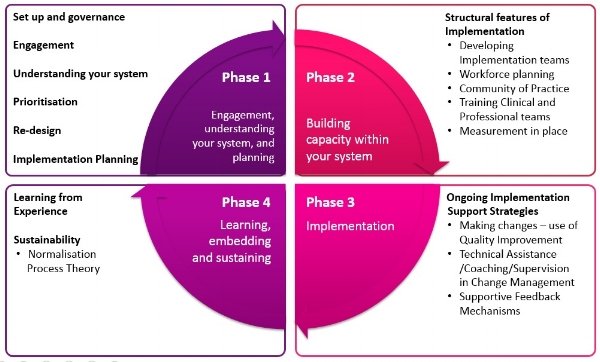How Can a Process Model Help You?
By Dr. Julia E. Moore, Executive Director
Note: We have updated our website since this article was published. As a result, you may have been redirected here from a previous URL. If you are looking for the article, “Project Spotlight: Developing a plan for the implementation and evaluation of a provincial surveillance project: application of the Quality Implementation Framework (QIF)” by Andrea Chaplin, please click here.
What does it mean to apply implementation science? This is a challenging question without a clear answer. Implementation science is multi-disciplinary and affects many aspects of implementation. So what are the practicable aspects of implementation science? These are are generally considered to be implementation science theories, models, and frameworks. These theories, models, and frameworks make up the architecture or backbone of applying implementation science (Nilsen, 2015).
Let’s start by defining and distinguishing theories, models, and frameworks.
Theories describe causal mechanisms of change – how people, organizations, and/or systems change. They are about predicting what will happen.
Models (or process models) specify the stages in a process. These stages do not need to be linear and often involve an iterative, back-and-forth process.
Frameworks present factors that may influence the implementation process or outcomes.
Theories, models and frameworks are all collectively required to effectively carry out implementation. This is because there is no one theory, model or framework that describes the complexity of practical implementation from start to finish. When applying implementation science, process models are the best place to begin. They are actionable and provide concrete guidance in the form of stages or steps of implementation. Each stage or step of implementation described in a process model can be informed by considering additional models or frameworks (for example, the contextual factors that may influence implementation). While all implementation efforts should also include a theory to explain the mechanisms of change, it is the process model that provides the roadmap for your journey.
Unfortunately, existing theories, models, and frameworks do not always use these definitions. It is fairly common that something is called a framework when it’s a process model or called a theory when it’s a framework, so take a look at the purpose to figure out which definition fits best.
As with everything in implementation, there is no “one size fits all”. Different process models are best suited to different situations. For example, if you are planning to implement a guideline or best practice, you’ll need to identify implementation strategies; a process model like the Knowledge to Action cycle can help you get there. If you’re working on implementing a program, a process model like Active Implementation, Getting to Outcomes or the Quality Implementation Framework might be a better fit.
Some implementers are hesitant to use a process model because it does not fit perfectly with their project or context. This is a lost opportunity, since these process models are based on reviews of the literature and provide the best available evidence about what stages should be considered and included. Researchers who develop process models typically have a project or type of implementation in mind when they develop them. When they are applied to a new context, it’s not surprising that the models would need to be adapted, and some process models are easier to adapt than others.
In this issue, Dr. Andrea Chaplin describes how she used the Quality Implementation Framework. Note that although it’s called a “framework” – it really presents steps in the implementation process, so it is better identified as a process model than a framework.
The Quality Implementation Framework is based on a review of 25 implementation frameworks and 14 critical steps were identified in the process. For each of the 14 steps important questions to consider were also highlighted. As a result, this process model is easy to understand and really easy to adapt. When I use it, I typically change the order of the steps based on the context in which I am implementing. Dr. Andrea Chaplin will describe how she adapted questions when she used it for a slightly different purpose – building and evaluating a data sharing repository.
Have fun picking your process model!
This article was featured in our monthly Implementation in Action bulletin! Want to receive our next issue? Subscribe here.

